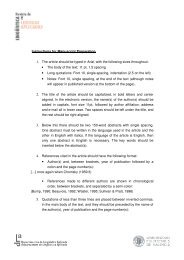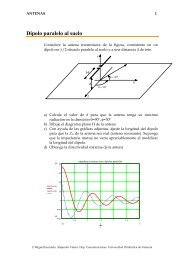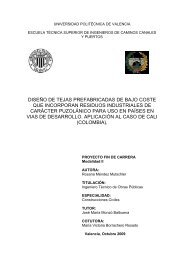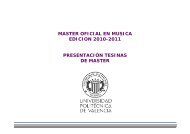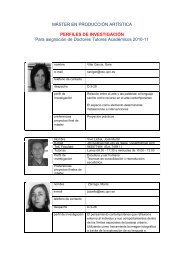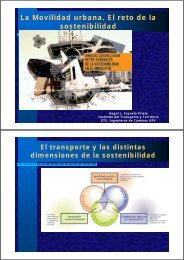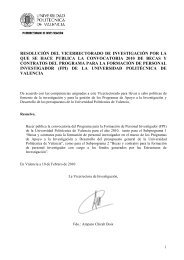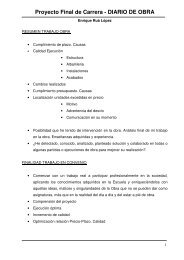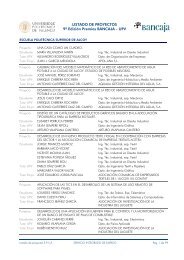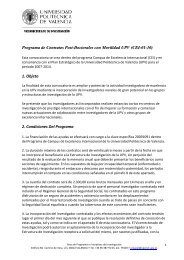ACP-EU Co-operation Programme in Higher Education (EDULINK II)
ACP-EU Co-operation Programme in Higher Education (EDULINK II)
ACP-EU Co-operation Programme in Higher Education (EDULINK II)
Create successful ePaper yourself
Turn your PDF publications into a flip-book with our unique Google optimized e-Paper software.
Table of contentsDEFINITIONS 41. THE <strong>EDULINK</strong> <strong>II</strong> PROGRAMME 51.1 Background ........................................................................................................................................... 51.2 Objectives of the programme and priority issues ................................................................................. 61.3 F<strong>in</strong>ancial allocation provided by the contract<strong>in</strong>g authority .................................................................. 62. RULES FOR THIS CALL FOR PROPOSALS 82.1 Eligibility criteria .................................................................................................................................. 82.1.1 Eligibility of applicants: who may apply? .................................................................................................... 82.1.2 Partnerships and eligibility of partners ......................................................................................................... 92.1.3 Eligible actions: actions for which an application may be made ................................................................ 102.1.4 Eligibility of costs: costs which may be taken <strong>in</strong>to consideration for the grant ......................................... 132.2 how to apply and the procedures to follow ......................................................................................... 152.2.1 Application form ........................................................................................................................................ 152.2.2 Where and how to send the Applications ................................................................................................... 152.2.3 Deadl<strong>in</strong>e for submission of Applications ................................................................................................... 162.2.4 Further <strong>in</strong>formation for the Application ..................................................................................................... 162.3 Evaluation and selection of applications ............................................................................................ 172.4 Submission of support<strong>in</strong>g documents for provisionally selected applications ................................... 202.5 Notification of the <strong>Co</strong>ntract<strong>in</strong>g Authority’s decision ......................................................................... 212.5.1 <strong>Co</strong>ntent of the decision ................................................................................................................................. 212.5.2 Indicative time table ..................................................................................................................................... 222.6 <strong>Co</strong>nditions applicable to implementation of the action follow<strong>in</strong>g the <strong>Co</strong>ntract<strong>in</strong>g Authority's decisionto award a grant .................................................................................................................................. 223. LIST OF ANNEXES 23January 2012 Page 3 of 23
DEFINITIONS<strong>ACP</strong>Action or ProjectApplicantAssociateBeneficiaryBUDGETEDF contributionEDFEEAEFTAEstablished network<strong>EU</strong>OCTOwn contributionPartnerPartnership<strong>Co</strong>ntractorsTotal eligible costsAfrica, Caribbean and Pacific.The set of activities the partnership proposes to carry out.The lead <strong>in</strong>stitution with<strong>in</strong> the partnership that submits the proposaland, if the proposal is selected, signs the grant contract.Organisation that has a real role <strong>in</strong> the Action but cannot receivefund<strong>in</strong>g from this <strong>Programme</strong>, with the exception of per diem or travelcosts. Associates do not have to meet the eligibility criteria referred to<strong>in</strong> Section 2.1.1.The Applicant as the contract<strong>in</strong>g party with whom a grant contract willbe signed, if the proposal is selected.The European Union general budget.The amount of EDF grant requested by the partnership. It cannotexceed 85% of the total eligible costs and must be comprised with<strong>in</strong>the m<strong>in</strong>imum and maximum amounts specified <strong>in</strong> Section 1.3.European Development Fund.European Economic Area.European Free Trade Association.A consortium of organisations exist<strong>in</strong>g prior to submitt<strong>in</strong>g anapplication and fulfill<strong>in</strong>g a set of criteria described <strong>in</strong> Section 2.1.2.European Union.Overseas <strong>Co</strong>untries and Territories.The part of the total eligible costs funded from the Applicant's orpartners' own resources, or from sources other than the Budget of theEuropean Union or the European Development Fund, subject to thespecifications of Section 2.1.4.The <strong>in</strong>stitution - other than the Applicant – that is a member of thepartnership.The network of <strong>in</strong>stitutions, i.e., the Applicant and its partners,constituted for the purpose of submitt<strong>in</strong>g an application and, ifsuccessful, for implement<strong>in</strong>g the Action. It does not have to existpreviously, and its constitution has to be demonstrated by the signed‘Partnership Statements’ required under Section <strong>II</strong>I of the ApplicationForm.The grant beneficiaries have the possibility to award contracts tocontractors for necessary limited parts of the Action they cannotexecute themselves, e.g., the supply of products, execution of works, orprovision of services. They are neither partners nor associates, and aresubject to the General <strong>Co</strong>nditions and the Procurement Rules set out <strong>in</strong>the Annexes <strong>II</strong> and IV to the standard Grant <strong>Co</strong>ntract (see Annex G ofthese Guidel<strong>in</strong>es).The sum of the EDF (and/or Budget) contribution and owncontribution, subject to the specifications of Section 2.1.4.Other terms used <strong>in</strong> the present Guidel<strong>in</strong>es are def<strong>in</strong>ed <strong>in</strong> the glossary to the ‘Practical Guide to <strong>Co</strong>ntractprocedures for <strong>EU</strong> external actions’ which is available at the follow<strong>in</strong>g Internet address:http://ec.europa.eu/europeaid/work/procedures/documents/execution/edf_general/edf_a1glossary_en.docJanuary 2012 Page 4 of 23
1. THE <strong>EDULINK</strong> <strong>II</strong> PROGRAMME1.1 BACKGROUNDThe policy of the European Union (<strong>EU</strong>) is to provide support to <strong>Higher</strong> <strong>Education</strong> (HE) <strong>in</strong> <strong>ACP</strong> partnercountries <strong>in</strong> the context of a balanced approach to <strong>in</strong>vestment across the education sector as a whole. TheAfrican, Caribbean and Pacific (<strong>ACP</strong>) States affirmed their commitment to further re<strong>in</strong>force their highereducation systems <strong>in</strong> the Brussels Declaration on <strong>Education</strong> for Susta<strong>in</strong>able Development <strong>in</strong> <strong>ACP</strong> States, theBrussels Framework for Action, and the Brussels Resolution on the Role of <strong>Education</strong> <strong>in</strong> the Achievement ofthe Millennium Development Goals (MDGs).The importance of higher education <strong>in</strong> the <strong>ACP</strong> development agenda is also confirmed <strong>in</strong> the Intra-<strong>ACP</strong>Strategy Paper and Multiannual Indicative <strong>Programme</strong> 2008-2013, jo<strong>in</strong>tly agreed between the European<strong>Co</strong>mmission and the <strong>ACP</strong> Group of States. The Indicative <strong>Programme</strong> earmarks funds to foster capacitybuild<strong>in</strong>g and regional <strong>in</strong>tegration <strong>in</strong> the field of higher education.The latest communication on <strong>EU</strong> Development policy adopted by the <strong>Co</strong>llege on the 12 th October 2011"Increas<strong>in</strong>g the impact of <strong>EU</strong> Development Policy: an Agenda for Change" underl<strong>in</strong>es the necessity toenhance the <strong>EU</strong> support for quality education to give young people the knowledge and skills to be activemembers of an evolv<strong>in</strong>g society.Moreover, the mentioned latest communication also acknowledges the relevance of the energy andagriculture sectors as drivers of poverty eradication:In agriculture, the <strong>EU</strong> should support susta<strong>in</strong>able practices, <strong>in</strong>clud<strong>in</strong>g the safeguard<strong>in</strong>g of ecosystemservices, giv<strong>in</strong>g priority to locally-developed practices and focus<strong>in</strong>g on smallholder agriculture and rurallivelihoods, formation of producer groups, the supply and market<strong>in</strong>g cha<strong>in</strong>, and government efforts tofacilitate responsible private <strong>in</strong>vestment. The <strong>EU</strong> will cont<strong>in</strong>ue work<strong>in</strong>g on strengthen<strong>in</strong>g nutritionalstandards, food security governance and reduc<strong>in</strong>g food price volatility at <strong>in</strong>ternational level.In energy, the <strong>EU</strong> should offer technology and expertise as well as development fund<strong>in</strong>g, and should focus onthree ma<strong>in</strong> challenges: price volatility and energy security; climate change, <strong>in</strong>clud<strong>in</strong>g access to low carbontechnologies; and access to secure, affordable, clean and susta<strong>in</strong>able energy services.S<strong>in</strong>ce its launch <strong>in</strong> 2006, the <strong>EDULINK</strong> <strong>Programme</strong> has set up co-<strong>operation</strong> projects <strong>in</strong>volv<strong>in</strong>g 139 <strong>ACP</strong><strong>Higher</strong> <strong>Education</strong> Institutions (HEIs) from <strong>ACP</strong> States. The projects have been f<strong>in</strong>anced from a € 35 M totalbudget under the 9th European Development Fund (EDF).The current Call for Proposals is designed to cont<strong>in</strong>ue foster<strong>in</strong>g co-<strong>operation</strong> <strong>in</strong> the field of <strong>Higher</strong> <strong>Education</strong>between the countries of the African, Caribbean and Pacific Group of States (<strong>ACP</strong> States) and the EuropeanUnion. <strong>EDULINK</strong> will improve the effectiveness, management, visibility and hence the impact of <strong>ACP</strong>-<strong>EU</strong>co-<strong>operation</strong> <strong>in</strong> the field of higher education. The <strong>Programme</strong> aims at promot<strong>in</strong>g <strong>in</strong>novation <strong>in</strong> HEIs <strong>in</strong> the<strong>ACP</strong> States and, hence, at ensur<strong>in</strong>g their competitiveness <strong>in</strong> the global environment.January 2012 Page 5 of 23
1.2 OBJECTIVES OF THE PROGRAMME AND PRIORITY ISSUESThis Call for Proposals will select project proposals focused exclusively on the follow<strong>in</strong>g target areas:Energy access and efficiencyAgriculture and food securityObjectives and expected resultsThe global objectives of the <strong>EDULINK</strong> <strong>II</strong> <strong>Programme</strong> are:To foster capacity build<strong>in</strong>g and regional <strong>in</strong>tegration <strong>in</strong> the field of higher education through <strong>in</strong>stitutionalnetwork<strong>in</strong>g; andTo support higher education of quality, that is efficient and relevant to the needs of the labour marketand consistent with the <strong>ACP</strong> regions’ and member countries’ socio-economic development priorities.The specific objective of the <strong>EDULINK</strong> <strong>II</strong> <strong>Programme</strong> and of this Call for Proposals is to strengthen thecapacity of <strong>ACP</strong> HEIs at two levels:Management/adm<strong>in</strong>istration;Academic.The expected results of implement<strong>in</strong>g the <strong>EDULINK</strong> <strong>II</strong> <strong>Programme</strong> are:Enhanced contribution to national and regional policies and development plans for co<strong>operation</strong> <strong>in</strong>higher education;Increased <strong>in</strong>ter-<strong>in</strong>stitutional network<strong>in</strong>g between HEIs <strong>in</strong> the <strong>ACP</strong> and with <strong>EU</strong> HEIs, <strong>in</strong>clud<strong>in</strong>g<strong>in</strong>stitutions offer<strong>in</strong>g teacher tra<strong>in</strong><strong>in</strong>g, degrees and diplomas contribut<strong>in</strong>g to regional solutions to teachershortages;Improved management and f<strong>in</strong>ancial adm<strong>in</strong>istration of <strong>ACP</strong> HEIs;Upgraded qualifications of academic staff of <strong>ACP</strong> HEIs;Improved <strong>in</strong>stitutional frameworks to pursue academic programmes and academic excellence <strong>in</strong> <strong>ACP</strong>HEIs.Increased mobility of postgraduate students and teach<strong>in</strong>g staff through the provision of jo<strong>in</strong>tprogrammes;Delivered study programmes <strong>in</strong> high level skills required by the national and regional labour markets;Relevant national or regional quality assurance standards of study programmes are met.1.3 FINANCIAL ALLOCATION PROVIDED BY THE CONTRACTING AUTHORITYThe overall <strong>in</strong>dicative amount made available for this Call for Proposals is <strong>EU</strong>R 23 300 000 European Development Fund (EDF) : <strong>EU</strong>R 18 300 000; and Development <strong>Co</strong>-<strong>operation</strong> Instrument: Relations with South Africa: <strong>EU</strong>R 5 000 000.The <strong>Co</strong>ntract<strong>in</strong>g Authority reserves the right not to award all available funds.January 2012 Page 6 of 23
This Call for Proposals is divided <strong>in</strong>to 2 Lots, one for each of the above mentioned fund<strong>in</strong>g sources, withdifferent eligibility rules but identical objectives, results and activities. Information on the eligibility ofapplicants, their partners, types of actions and costs is provided <strong>in</strong> Section 2.1 of these Guidel<strong>in</strong>es forApplicants.Lot 1 – EDF – concerns the <strong>EU</strong>R 18 300 000 EDF contributionLot 2 – BUDGET – concerns the <strong>EU</strong>R 5 000 000 <strong>EU</strong> Budget l<strong>in</strong>e 21.06.02 contributionApplicants have to clearly specify <strong>in</strong> the first page of the Grant Application Form for which lot they areapply<strong>in</strong>g. Each proposal may be submitted under only one lot.In the case where the above amount foreseen for a specific lot cannot be used due to <strong>in</strong>sufficient quality ornumber of proposals received, the <strong>Co</strong>ntract<strong>in</strong>g Authority reserves the right to reallocate the rema<strong>in</strong><strong>in</strong>g fundsto another lot.Size of grantsGrants requested to support a) Energy access and efficiency and b) Agriculture and food security mustfall between the follow<strong>in</strong>g m<strong>in</strong>imum and maximum amounts: M<strong>in</strong>imum amount: <strong>EU</strong>R 200 000 Maximum amount: <strong>EU</strong>R 500 000Any grant awarded under this Call for Proposals must be limited to 85% of the estimated total acceptedcosts.The balance (i.e. the difference between the total cost of the action and the amount requested from the<strong>Co</strong>ntract<strong>in</strong>g Authority) must be f<strong>in</strong>anced from the applicant's or partners' own resources, or from sourcesother than the European Union Budget or the European Development Fund 1 .1 Where a grant is f<strong>in</strong>anced by the European Development Fund, any mention of European Union f<strong>in</strong>anc<strong>in</strong>g must be understood as referr<strong>in</strong>g toEuropean Development Fund f<strong>in</strong>anc<strong>in</strong>g.January 2012 Page 7 of 23
2. RULES FOR THIS CALL FOR PROPOSALSThese guidel<strong>in</strong>es set out the rules for the submission, selection and implementation of actions f<strong>in</strong>anced underthis Call, <strong>in</strong> conformity with the provisions of the Practical Guide to contract procedures for <strong>EU</strong> externalactions, which is applicable to the present call (available on the Internet at this address:http://ec.europa.eu/europeaid/work/procedures/implementation/<strong>in</strong>dex_en.htm).2.1 ELIGIBILITY CRITERIAThere are three sets of eligibility criteria, relat<strong>in</strong>g to: Applicant(s) which may request a grant (2.1.1), and their partners (2.1.2); Actions for which a grant may be awarded (2.1.3); Types of cost which may be taken <strong>in</strong>to account <strong>in</strong> sett<strong>in</strong>g the amount of the grant (2.1.4).2.1.1 Eligibility of applicants: who may apply?(1) In order to be eligible for a grant, applicants must:Be legal persons andBe registered for a m<strong>in</strong>imum period of three years at the time of publication of the present Call andBe directly responsible for the preparation and management of the action with their partners, not act<strong>in</strong>gas an <strong>in</strong>termediary and be established <strong>in</strong> 2 :o Lot 1 – EDF: one of the countries listed <strong>in</strong> Annex I for "Lot 1 – EDF"o Lot 2 – BUDGET: one of the countries listed <strong>in</strong> Annex I for "Lot 2 – BUDGET "And be a public or private 3 HEI 4 (or an Entity with<strong>in</strong> such an <strong>in</strong>stitution with a legal status thatallows it to apply on its own behalf), a network 5 of HEI, or a Regional Institutions of <strong>Higher</strong><strong>Education</strong> not belong<strong>in</strong>g to any national system, but formally recognised by one of the eligiblecountries.2 To be determ<strong>in</strong>ed on the basis of the organisation's statutes which should demonstrate that it has been established by an <strong>in</strong>strument governed bythe national law of the country concerned. In this respect, any legal entity whose statutes have been established <strong>in</strong> another country cannot beconsidered an eligible local organisation, even if the statutes are registered locally or a “Memorandum of Understand<strong>in</strong>g” has been concluded.3 Please note that that the grant can under no circumstances result <strong>in</strong> a profit for itself and that it must be limited to the amount required to balance<strong>in</strong>come and expenditure for the Action (article 17.3 of the general conditions of the grant contract)4 In order to be eligible as a <strong>Higher</strong> <strong>Education</strong> Institution, applicants must provide courses at the undergraduate and/or graduate level of highereducation lead<strong>in</strong>g to a qualification recognised by the competent authorities <strong>in</strong> their own country. They may be called a “University” or bearanother relevant name (“Polytechnic”, “<strong>Co</strong>llege”, “Institute”, etc).5 Please note that an established network acts as an entity and corresponds to only one member with<strong>in</strong> a partnership.January 2012 Page 8 of 23
(2) Potential applicants may not participate <strong>in</strong> calls for proposals or be awarded grants if they are <strong>in</strong> anyof the situations which are listed <strong>in</strong> Section 2.3.3 of the Practical Guide to contract procedures for<strong>EU</strong> external actions (available from the follow<strong>in</strong>g Internet address:http://ec.europa.eu/europeaid/work/procedures/implementation/<strong>in</strong>dex_en.htm);In Part B section 7 of the grant application form (“Declaration by the applicant”), applicants must declarethat they do not fall <strong>in</strong>to any of these situations.Please note that:Organisations (<strong>in</strong>clud<strong>in</strong>g NGOs) from countries that are not <strong>in</strong> the list of eligible countries cannevertheless participate <strong>in</strong> projects as “associates”, under the conditions established <strong>in</strong> section 2.1.2 ofthese Guidel<strong>in</strong>es.Independent Research Institutes (RI), as such, are not eligible. A RI can be an associate, under theconditions established <strong>in</strong> section 2.1.2 of these Guidel<strong>in</strong>es.2.1.2 Partnerships and eligibility of partnersApplicants must act with partner organisations as specified hereafter:The partnership must <strong>in</strong>volve at least 3 partners, <strong>in</strong>clud<strong>in</strong>g the applicant. There is no upper limit to thenumber of HEIs <strong>in</strong>cluded; The partnership must <strong>in</strong>volve partners from at least 2 different <strong>ACP</strong> States 6 as def<strong>in</strong>ed <strong>in</strong> annex I;HEIs that have campuses <strong>in</strong> different countries are considered as one entity. They cannot use theircampuses as partners, but must create a partnership with other <strong>in</strong>dependent HEIs. However, more thanone campus of a particular entity can be <strong>in</strong>volved <strong>in</strong> the same project;The number of <strong>in</strong>stitutions from the <strong>ACP</strong> States must always be greater than the number of<strong>in</strong>stitutions from the <strong>EU</strong> or from other regions (non-<strong>ACP</strong>);The Application must <strong>in</strong>clude a Partnership Statement signed by each partner, confirm<strong>in</strong>g that theyare familiar with the contents of the application and understand their role and responsibilities <strong>in</strong> theproposed action. Each member of a partnership must have a precise and clearly identified role <strong>in</strong> theproject;Applicants' partners participate <strong>in</strong> design<strong>in</strong>g and implement<strong>in</strong>g the action, and the costs they <strong>in</strong>curare eligible <strong>in</strong> the same way as those <strong>in</strong>curred by the grant beneficiary. They must therefore satisfy theeligibility criteria as applicable on the grant beneficiary himself.The follow<strong>in</strong>g are not partners and do not have to sign the “partnership statement”:Associates: other organisations may be <strong>in</strong>volved <strong>in</strong> the action. Such associates play a real role <strong>in</strong> theaction but may not receive fund<strong>in</strong>g from the grant with the exception of per diem or travel costs.Associates do not have to meet the eligibility criteria referred to <strong>in</strong> section 2.1.1. The associates have tobe mentioned <strong>in</strong> Part B section 5 - “Associates of the Applicant participat<strong>in</strong>g <strong>in</strong> the Action” of the GrantApplication Form.6 See annex I for the list of <strong>ACP</strong> StatesJanuary 2012 Page 9 of 23
<strong>Co</strong>ntractors: the grant beneficiaries have the possibility to award contracts. <strong>Co</strong>ntractors are neitherpartners nor associates, and are subject to the procurement rules set out <strong>in</strong> Annex IV to the standardgrant contract.The applicant will act as the lead organisation and, if selected, as the contract<strong>in</strong>g party (the "Beneficiary").2.1.3 Eligible actions: actions for which an application may be madeDef<strong>in</strong>ition:An action (or project) is composed of a set of activities.DurationThe <strong>in</strong>itial planned duration of an action may not be less than 12 months nor exceed 42 months.When determ<strong>in</strong><strong>in</strong>g the duration of the project, applicants should consider a start-up (<strong>in</strong>ception) phase (e.g.recruitment of staff, <strong>in</strong>stallation of <strong>in</strong>frastructures, etc.) and an exit strategy (activity wrap–up, resultsdissem<strong>in</strong>ation, susta<strong>in</strong>ability plan, etc.).Sector: <strong>Higher</strong> <strong>Education</strong>With<strong>in</strong> the framework of the modernisation agenda of <strong>Higher</strong> <strong>Education</strong> <strong>in</strong> <strong>ACP</strong> States, <strong>EDULINK</strong> <strong>II</strong>projects selected with<strong>in</strong> this Call for Proposals will aim at support<strong>in</strong>g HEIs <strong>in</strong> <strong>ACP</strong> States to create new andupgrade exist<strong>in</strong>g curricula and teach<strong>in</strong>g methods, re<strong>in</strong>force l<strong>in</strong>ks between teach<strong>in</strong>g, modern technologies,lifelong learn<strong>in</strong>g and research, as well as strengthen<strong>in</strong>g their management and adm<strong>in</strong>istration capacity.The proposed projects must exclusively address the target areas <strong>in</strong>dicated <strong>in</strong> section 1.2. With<strong>in</strong> thisframework, the thematic fields of study may <strong>in</strong>clude:Energy access and efficiency Innovative solutions to improve access to energy; Use of modern technologies; Renewable energies; Reduction of greenhouse gas emissions; Policies and strategies to cleaner, stable electricity services (e.g. to households and bus<strong>in</strong>esses); Improved <strong>in</strong>frastructures.Agriculture and food security Value cha<strong>in</strong>s efficiency; Regional agricultural and food markets; Nutrition/malnutrition issues; Veter<strong>in</strong>ary sciences Susta<strong>in</strong>able fish<strong>in</strong>g and monitor<strong>in</strong>g systems; Improved <strong>in</strong>frastructures.Please note that the above list is not exhaustive.L<strong>in</strong>kages with relevant <strong>ACP</strong> countries' national and/or regional development strategies and EDF <strong>in</strong>dicativeprogrammes 7 should be identified.7 Reference documents: EDF National and Regional Indicative programmes/strategy papers (http://ec.europa.eu/europeaid/how/f<strong>in</strong>ance/edf_en.htm)January 2012 Page 10 of 23
Applicants should make sure that proposed activities do not overlap with those eligible under other<strong>Programme</strong>s implemented with<strong>in</strong> the <strong>ACP</strong>-<strong>EU</strong> agreement (e.g. Intra-<strong>ACP</strong> mobility scheme, Energy Facility,<strong>ACP</strong> programmes <strong>in</strong> support of research).Cross-Cutt<strong>in</strong>g IssuesWhile address<strong>in</strong>g the above-referred priority areas and objectives, and tak<strong>in</strong>g <strong>in</strong>to consideration the overalldevelopment policies’ objectives, such as the eradication of poverty and the promotion of economic growthand <strong>in</strong>clusiveness, the issues below shall be addressed by the <strong>Programme</strong> and hence by the projectapplications:Good governance;Environmental susta<strong>in</strong>ability;HIV/AIDS;Gender equality.<strong>Higher</strong> education systems <strong>in</strong> <strong>ACP</strong> countries commonly present a gender imbalance. As a result, applicantsare <strong>in</strong>vited to submit proposals that focus on gender equality and how to decrease the exist<strong>in</strong>g gender divide<strong>in</strong> terms of access to higher education and labour markets.All applicants are required to address gender issues related to their proposals.LocationActions should take place <strong>in</strong> one or more of the <strong>ACP</strong> Member States as listed <strong>in</strong> Annex I.Types of actionThe actions which may be f<strong>in</strong>anced under this call are projects of <strong>in</strong>stitutional and academic co-<strong>operation</strong>,concern<strong>in</strong>g the applicants and its partner-organizations, aimed at:Institutional capacity build<strong>in</strong>g of the <strong>ACP</strong> HEIs <strong>in</strong> support of policy, management, plann<strong>in</strong>g andadm<strong>in</strong>istrative capacity;Improv<strong>in</strong>g academic quality and relevance <strong>in</strong> the regional or sub-regional context.Supported actions will aim at achiev<strong>in</strong>g concrete and <strong>in</strong>novative results <strong>in</strong> the field of higher educationrelevant to the socio-economic development priorities of the <strong>ACP</strong> countries and/or regions as well as topromote, demonstrate and dissem<strong>in</strong>ate the results achieved.These actions should be implemented <strong>in</strong> the areas identified <strong>in</strong> section 1.2 above:Energy access and efficiencyAgriculture and food security.Types of ActivityAll projects must <strong>in</strong>clude project management activities (e.g. Management of meet<strong>in</strong>gs between partners;participation at stakeholders meet<strong>in</strong>gs) and a detailed description of such activities. The non-exhaustive listbelow shows some types of activities that may be f<strong>in</strong>anced for each proposed action:Management/adm<strong>in</strong>istration capacity of the <strong>ACP</strong> HEIs: establishment or strengthen<strong>in</strong>g<strong>in</strong>ternational relations units with<strong>in</strong> HEIs; capacity build<strong>in</strong>g to support student and staff mobilityactivities; creat<strong>in</strong>g or <strong>in</strong>creas<strong>in</strong>g the capacity of plann<strong>in</strong>g and evaluation units with<strong>in</strong> the HEIs;<strong>in</strong>ternationalisation of campuses; establish<strong>in</strong>g new or develop<strong>in</strong>g exist<strong>in</strong>g quality assurance units with<strong>in</strong>January 2012 Page 11 of 23
HEIs; enhanc<strong>in</strong>g mechanisms for communication and dissem<strong>in</strong>ation of results from <strong>EDULINK</strong> projects;short and/or medium term study visits.Academic capacity of the <strong>ACP</strong> HEIs: develop<strong>in</strong>g and implement<strong>in</strong>g new curricula; develop<strong>in</strong>gcapacities for postgraduate student exchanges, jo<strong>in</strong>t development of curricula, jo<strong>in</strong>t degrees/diplomas;academic staff exchanges; regional courses/sem<strong>in</strong>ars for tra<strong>in</strong><strong>in</strong>g academic staff; teacher tra<strong>in</strong><strong>in</strong>gcourses for HEI academic staff; postgraduate student and/or staff mobility; develop<strong>in</strong>g andimplement<strong>in</strong>g credit transfer processes; the promotion, dissem<strong>in</strong>ation and demonstration of projectresults and/or best practices, e.g. web pages, draft<strong>in</strong>g documents, studies, dissem<strong>in</strong>ation events.Sub-grant<strong>in</strong>gSub-grant<strong>in</strong>g is not allowed under this Call for Proposals.VisibilityNote that the applicant must comply with the objectives and priorities and guarantee the visibility of the <strong>EU</strong>f<strong>in</strong>anc<strong>in</strong>g(see the <strong>Co</strong>mmunication and Visibility Manual for <strong>EU</strong> external actions laid down and published bythe European <strong>Co</strong>mmission at (see http://ec.europa.eu/europeaid/work/visibility/<strong>in</strong>dex_en.htm).Ineligible actionsThe follow<strong>in</strong>g types of action are <strong>in</strong>eligible:Actions concerned only or ma<strong>in</strong>ly with <strong>in</strong>dividual sponsorships for participation <strong>in</strong> workshops,sem<strong>in</strong>ars, conferences, congresses;Actions that foresee <strong>in</strong>dividual scholarships for studies or tra<strong>in</strong><strong>in</strong>g courses.Number of applications and grants per applicantAn applicant may submit more than one application under this Call for Proposals if the majority of thepartners are different for each application and if the proposals are for projects that are clearly different <strong>in</strong>content or geographical coverage. Please note that, <strong>in</strong> this case, each proposal must be submitted <strong>in</strong>dividuallyand separately.An applicant may be at the same time partner <strong>in</strong> another application.Partners may take part <strong>in</strong> more than one application.Applicants to whom a grant was awarded under one or more of the previous <strong>EDULINK</strong> I Calls for Proposalsmay <strong>in</strong>troduce a new project proposal under this <strong>EDULINK</strong> <strong>II</strong> call. <strong>Co</strong>nsortia that have been awarded a grantunder <strong>EDULINK</strong> I may apply with the same partnership composition provided the new project proposal isclearly different from their proposals funded under previous calls.January 2012 Page 12 of 23
2.1.4 Eligibility of costs: costs which may be taken <strong>in</strong>to consideration for the grantOnly "eligible costs" can be taken <strong>in</strong>to account for a grant. The categories of costs considered as eligible andnon-eligible are <strong>in</strong>dicated below. The budget is both a cost estimate and a ceil<strong>in</strong>g for "eligible costs". Notethat the eligible costs must be based on real costs based on support<strong>in</strong>g documents (except for subsistencecosts and <strong>in</strong>direct costs where flat-rate fund<strong>in</strong>g applies).Recommendations to award a grant are always subject to the condition that the check<strong>in</strong>g process whichprecedes the sign<strong>in</strong>g of the contract does not reveal problems requir<strong>in</strong>g changes to the budget (for <strong>in</strong>stancearithmetical errors, <strong>in</strong>accuracies or unrealistic costs and other <strong>in</strong>eligible costs). The checks may give rise torequests for clarification and may lead the <strong>Co</strong>ntract<strong>in</strong>g Authority to impose modifications or reductions toaddress such mistakes or <strong>in</strong>accuracies. The amount of the grant and the percentage of the <strong>EU</strong> co-f<strong>in</strong>anc<strong>in</strong>g asa result of these corrections may not be <strong>in</strong>creased.It is therefore <strong>in</strong> the applicant's <strong>in</strong>terest to provide a realistic and cost-effective budget.Claimed costs must be duly justified, and <strong>in</strong> particular, it should be noted that the f<strong>in</strong>anc<strong>in</strong>g of items such asequipment and travels should be limited to the m<strong>in</strong>imum necessary for the implementation of the actionEligible direct costsTo be eligible under the Call for Proposals, costs must comply with the provisions of Article 14 of theGeneral <strong>Co</strong>nditions to the Standard Grant <strong>Co</strong>ntract (see Annex G of the Guidel<strong>in</strong>es).Note that taxes, <strong>in</strong>clud<strong>in</strong>g VAT will only be accepted as eligible costs when the Beneficiary (or, whereapplicable, its partners) can show it cannot reclaim them. Taxes shall <strong>in</strong> such case be <strong>in</strong>cluded <strong>in</strong> the Budgetof the Action under each head<strong>in</strong>g. Information on taxes can be found <strong>in</strong> Annex J to these Guidel<strong>in</strong>es.Staff costsStaff cost shall mean any payment made to a person work<strong>in</strong>g on a regular or recurrent basis for the project,whether as staff member of a participant HEI or as sub-contracted professional.Staff costs shall be calculated on the basis of the normal salary paid by the HEI to the concerned staff member,for the number of months/days to be spent on the project (i.e. no special “<strong>in</strong>ternational project” rate should beused). This calculation shall <strong>in</strong>clude all the normal charges paid by the employer, such as social securitycontributions and related costs, but shall exclude any bonus. The salary claimed should be justified by <strong>in</strong>clud<strong>in</strong>ga copy of the HEI’s salary schedule and/or copies of the latest monthly pay slips of the <strong>in</strong>dividual staff members.Specific funds <strong>in</strong> the budget should be dedicated to the management of the project and to enhance the projectmanagement expertise of partners. In addition, and with the purpose of avoid<strong>in</strong>g weak report<strong>in</strong>g (and <strong>in</strong>particular f<strong>in</strong>ancial report<strong>in</strong>g), the project application should <strong>in</strong>clude the necessary provisions to allocate astaff member with the appropriate adm<strong>in</strong>istrative / account<strong>in</strong>g know-how to the tasks of document keep<strong>in</strong>gand report<strong>in</strong>g, <strong>in</strong> particular f<strong>in</strong>ancial report<strong>in</strong>g.A specific budget allocation for “Adm<strong>in</strong>istrative/support staff (bookkeep<strong>in</strong>g & f<strong>in</strong>ancial report<strong>in</strong>g)” must beentered under 1.1.3. Annex B, Budget for the Action.For other personnel engaged <strong>in</strong> the project, the unit rates must be actual local market rates and must beexpla<strong>in</strong>ed <strong>in</strong> the budget justification.January 2012 Page 13 of 23
Participation <strong>in</strong> stakeholder meet<strong>in</strong>gsFor stakeholder meet<strong>in</strong>gs organised by the <strong>Co</strong>ntract<strong>in</strong>g Authority, an amount of <strong>EU</strong>R 10,000 must be enteredunder the budget head<strong>in</strong>g 'Travel costs'.<strong>Co</strong>nt<strong>in</strong>gency reserveA cont<strong>in</strong>gency reserve not exceed<strong>in</strong>g 5% of the estimated direct eligible costs may be <strong>in</strong>cluded <strong>in</strong> the Budgetof the Action. It can only be used with the prior written authorisation of the <strong>Co</strong>ntract<strong>in</strong>g Authority.Eligible <strong>in</strong>direct costs (overheads)The <strong>in</strong>direct costs <strong>in</strong>curred <strong>in</strong> carry<strong>in</strong>g out the action may be eligible for flat-rate fund<strong>in</strong>g fixed at not morethan 7% of the estimated total eligible direct costs. Indirect costs are eligible provided that they do not<strong>in</strong>clude costs assigned to another head<strong>in</strong>g of the budget of the standard grant contract. The applicant may beasked to justify the requested percentage before contract<strong>in</strong>g. However, once the flat-rate has been fixed <strong>in</strong> thespecial conditions of the standard grant contract, no support<strong>in</strong>g documents need to be provided.If the applicant is <strong>in</strong> receipt of an operat<strong>in</strong>g grant f<strong>in</strong>anced from the <strong>EU</strong>, no <strong>in</strong>direct costs may be claimedwith<strong>in</strong> the proposed budget for the action.<strong>Co</strong>ntributions <strong>in</strong> k<strong>in</strong>d<strong>Co</strong>ntributions <strong>in</strong> k<strong>in</strong>d are not considered actual expenditure and are not eligible costs. The contributions <strong>in</strong>k<strong>in</strong>d may not be treated as co-f<strong>in</strong>anc<strong>in</strong>g by the Beneficiary.The cost of staff assigned to the Action is not a contribution <strong>in</strong> k<strong>in</strong>d.Notwithstand<strong>in</strong>g the above, if the description of the action as proposed by the Beneficiary foresees thecontributions <strong>in</strong> k<strong>in</strong>d, such contributions have to be provided.Ineligible costsThe follow<strong>in</strong>g costs are not eligible:– debts and debt service charges– provisions for losses or potential future liabilities;– <strong>in</strong>terest owed;– costs declared by the beneficiary and covered by another action or work programme;– purchases of land or build<strong>in</strong>gs, except where necessary for the direct implementation of the action, <strong>in</strong>which case ownership must be transferred to the f<strong>in</strong>al beneficiaries and/or local partners, at the latest bythe end of the action;– currency exchange losses;– credit to third parties.January 2012 Page 14 of 23
2.2 HOW TO APPLY AND THE PROCEDURES TO FOLLOWPlease note that the prior registration <strong>in</strong> PADOR 8 for applicants and their partners for this Call for Proposalsis not obligatory. Information <strong>in</strong> PADOR will not be drawn <strong>in</strong> the present Call.2.2.1 Application formApplications must be submitted <strong>in</strong> accordance with the <strong>in</strong>structions on the <strong>Co</strong>ncept Note and the Fullapplication form <strong>in</strong>cluded <strong>in</strong> the Grant Application Form annexes to these Guidel<strong>in</strong>es (Annex A)Applicants must apply <strong>in</strong> English or <strong>in</strong> French.Any error or major discrepancy related to the po<strong>in</strong>ts listed <strong>in</strong> the <strong>in</strong>structions on the <strong>Co</strong>ncept Note or anymajor <strong>in</strong>consistency <strong>in</strong> the application form (e.g. the amounts mentioned <strong>in</strong> the budget worksheets are<strong>in</strong>consistent) may lead to the rejection of the application.Clarifications will only be requested when <strong>in</strong>formation provided is unclear, thus prevent<strong>in</strong>g the <strong>Co</strong>ntract<strong>in</strong>gAuthority from conduct<strong>in</strong>g an objective assessment.Hand-written applications will not be accepted.Please note that only the application form and the published annexes which have to be filled <strong>in</strong> (budget,logical framework) will be evaluated. It is therefore of utmost importance that these documents conta<strong>in</strong> ALLrelevant <strong>in</strong>formation concern<strong>in</strong>g the action. No additional annexes should be sent.2.2.2 Where and how to send the ApplicationsApplications must be submitted <strong>in</strong> one orig<strong>in</strong>al and two copies <strong>in</strong> A4 size, each bound. The completeapplication form (Part A: concept note and Part B: full application form), budget and logical framework mustalso be supplied <strong>in</strong> electronic format (CD-Rom) <strong>in</strong> a separate and unique file (e.g. the application form mustnot be split <strong>in</strong>to several different files). The electronic format must conta<strong>in</strong> exactly the same application asthe paper version enclosed.The Checklist (Section 6 of Part B the grant application form) and the Declaration by the applicant (Section7 of Part B of the grant application form) must be stapled separately and enclosed <strong>in</strong> the envelopeWhere an applicant sends several different applications, each one has to be sent separately.The outer envelope must bear the reference number and the title of the Call for Proposals, together withthe title and number of the lot, the full name and address of the applicant, and the words "Not to be openedbefore the open<strong>in</strong>g session".Applications must be submitted <strong>in</strong> a sealed envelope by registered mail, private courier service or by handdelivery(a signed and dated certificate of receipt will be given to the deliverer) at the address below:Postal address<strong>EDULINK</strong><strong>Programme</strong> Management Unitc/o GOPA-CartermillRue de Trèves, 45B1040 BrusselsAddress for hand delivery or by private courier service<strong>EDULINK</strong><strong>Programme</strong> Management Unitc/o GOPA-CartermillRue de Trèves, 45B1040 Brussels8For further <strong>in</strong>formation on PADOR, please consult the follow<strong>in</strong>g website:http://ec.europa.eu/europeaid/work/onl<strong>in</strong>eservices/pador/<strong>in</strong>dex_en.htmHelpdesk for questions related to the function<strong>in</strong>g of PADOR:Europeaid-ON-LINE-REGISTRATION-HD@ec.europa.euJanuary 2012 Page 15 of 23
Applications sent by any other means (e.g. by fax or by e-mail) or delivered to other addresses will berejected.Applicants must verify that their application is complete us<strong>in</strong>g the checklist (Section 6 of Part B of thegrant application form). Incomplete applications may be rejected.2.2.3 Deadl<strong>in</strong>e for submission of ApplicationsThe deadl<strong>in</strong>e for the submission of applications is 30 July 2012 as evidenced by the date of dispatch, thepostmark or the date of the deposit slip. In the case of hand-deliveries, the deadl<strong>in</strong>e for receipt is at 16:00local time as evidenced by the signed and dated receipt. Any application submitted after the deadl<strong>in</strong>e willautomatically be rejected.However, for reasons of adm<strong>in</strong>istrative efficiency, the <strong>Co</strong>ntract<strong>in</strong>g Authority may reject any applicationreceived after the effective date of approval of the first evaluation step (i.e. <strong>Co</strong>ncept Note) (see <strong>in</strong>dicativecalendar under Section 2.5.2).2.2.4 Further <strong>in</strong>formation for the ApplicationQuestions may be sent by e-mail no later than 21 days before the deadl<strong>in</strong>e for the submission of applicationsto the below address, <strong>in</strong>dicat<strong>in</strong>g clearly the reference of the Call for Proposals:E-mail address: Call2012@acp-edul<strong>in</strong>k.eu<strong>Co</strong>ntract<strong>in</strong>g Authority has no obligation to provide further clarifications after this date.Replies will be given no later than 11 days before the deadl<strong>in</strong>e for the submission of applications.In the <strong>in</strong>terest of equal treatment of applicants, the <strong>Co</strong>ntract<strong>in</strong>g Authority cannot give a prior op<strong>in</strong>ion on theeligibility of an applicant, a partner, an action or specific activities.Questions that may be relevant to other applicants, together with the answers, will be published on theEuropeAid (https://webgate.ec.europa.eu/europeaid/onl<strong>in</strong>e-services/<strong>in</strong>dex.cfm?do=publi.welcome) and<strong>EDULINK</strong> (www.acp-edul<strong>in</strong>k.eu) websites. It is therefore highly recommended to regularly consult theabovementioned websites <strong>in</strong> order to be <strong>in</strong>formed of the questions and answers published.January 2012 Page 16 of 23
2.3 EVALUATION AND SELECTION OF APPLICATIONSApplications will be exam<strong>in</strong>ed and evaluated by the <strong>Co</strong>ntract<strong>in</strong>g Authority with the possible assistance ofexternal assessors. All actions submitted by applicants will be assessed accord<strong>in</strong>g to the follow<strong>in</strong>g steps andcriteria.If the exam<strong>in</strong>ation of the application reveals that the proposed action does not meet the eligibility criteriastated <strong>in</strong> paragraph 2.1.3, the application shall be rejected on this sole basis.(1) STEP 1: OPENING & ADMINISTRATIVE CHECKS AND CONCEPT NOTEEVALUATIONThe follow<strong>in</strong>g will be assessed:The submission deadl<strong>in</strong>e has been respected. If the deadl<strong>in</strong>e has not been respected the applicationwill automatically be rejected.The Application Form satisfies all the criteria specified <strong>in</strong> po<strong>in</strong>ts 1-5 of the Checklist (Section 6 ofPart B of the grant application form). If any of the requested <strong>in</strong>formation is miss<strong>in</strong>g or is <strong>in</strong>correct,the application may be rejected on that sole basis and the application will not be evaluated further.The evaluation of the <strong>Co</strong>ncept Notes that have passed the adm<strong>in</strong>istrative check will cover the relevance anddesign of the action.The <strong>Co</strong>ncept Note will be given an overall score out of 50 po<strong>in</strong>ts <strong>in</strong> accordance with the breakdown provided<strong>in</strong> the Evaluation Grid below. The evaluation shall also verify the compliance with <strong>in</strong>structions provided <strong>in</strong>the guidance for <strong>Co</strong>ncept Note.The evaluation criteria are divided <strong>in</strong>to head<strong>in</strong>gs and subhead<strong>in</strong>gs. Each subhead<strong>in</strong>g will be given a scorebetween 1 and 5 <strong>in</strong> accordance with the follow<strong>in</strong>g assessment categories: 1 = very poor; 2 = poor; 3 =adequate; 4 = good; 5 = very good.Scores1. Relevance of the action Sub-score 301.1How relevant is the proposal to the objectives and priorities of the Call for Proposals? 5x2*1.2 How relevant to the particular needs and constra<strong>in</strong>ts of the target country(ies) orregion(s) is the proposal? (<strong>in</strong>clud<strong>in</strong>g synergy with other <strong>EU</strong> <strong>in</strong>itiatives and avoidanceof duplication)1.3 How clearly def<strong>in</strong>ed and strategically chosen are those <strong>in</strong>volved (f<strong>in</strong>al beneficiaries,target groups)? Have their needs been clearly def<strong>in</strong>ed and does the proposal addressthem appropriately?1.4 Does the proposal conta<strong>in</strong> specific added-value elements, such as environmentalsusta<strong>in</strong>ability, good governance, promotion of gender equality and equal opportunities,needs of disabled people, rights of m<strong>in</strong>orities and rights of <strong>in</strong>digenous peoples, or<strong>in</strong>novation and best practices5x2*552. Design of the action Sub-score 202.1 How coherent is the overall design of the action?In particular, does it reflect the analysis of the problems <strong>in</strong>volved, take <strong>in</strong>to accountexternal factors and relevant stakeholders?2.2 Is the action feasible and consistent <strong>in</strong> relation to the objectives and expected results? 5x2** the scores are multiplied by 2 because of their importanceJanuary 2012 Page 17 of 235x2*TOTAL SCORE 50
Once all <strong>Co</strong>ncept Notes have been assessed, a list will be established with the proposed actions rankedaccord<strong>in</strong>g to their total score.First, only the <strong>Co</strong>ncept Notes which have been given a score of a m<strong>in</strong>imum of 30 po<strong>in</strong>ts will be consideredfor pre-selection.Secondly, the list of <strong>Co</strong>ncept Notes will be reduced <strong>in</strong> accordance to the rank<strong>in</strong>g to those whose sum ofrequested contributions amounts to <strong>EU</strong>R 46 600 000, tak<strong>in</strong>g <strong>in</strong>to account the <strong>in</strong>dicative f<strong>in</strong>ancial envelopesforeseen by lot.Follow<strong>in</strong>g the <strong>Co</strong>ncept Note evaluation, the <strong>Co</strong>ntract<strong>in</strong>g Authority will send a letter to all applicants,<strong>in</strong>dicat<strong>in</strong>g whether their application was submitted prior to the deadl<strong>in</strong>e, <strong>in</strong>form<strong>in</strong>g them of the referencenumber they have been allocated and whether the <strong>Co</strong>ncept Note were evaluated and the results of thatevaluation.The Evaluation <strong>Co</strong>mmittee will subsequently proceed with the applicants whose proposals have been preselected.(2) STEP 2: EVALUATION OF THE FULL APPLICATIONFirst, it will be assessed if the full application form satisfies all the criteria specified <strong>in</strong> po<strong>in</strong>ts 1-8 of theChecklist (Section 6 of Part B of the grant application form). If any of the requested <strong>in</strong>formation is miss<strong>in</strong>gor is <strong>in</strong>correct, the application may be rejected on that sole basis and the application will not be evaluatedfurther.An evaluation of the quality of the applications, <strong>in</strong>clud<strong>in</strong>g the proposed budget, and of the capacity of theapplicant and its partners, will be subsequently carried out <strong>in</strong> accordance with the evaluation criteria set out<strong>in</strong> the Evaluation Grid <strong>in</strong>cluded below. There are two types of evaluation criteria: selection and awardcriteria.The selection criteria are <strong>in</strong>tended to help evaluate the applicants' f<strong>in</strong>ancial and <strong>operation</strong>al capacity toensure that they:have stable and sufficient sources of f<strong>in</strong>ance to ma<strong>in</strong>ta<strong>in</strong> their activity throughout the period dur<strong>in</strong>gwhich the action is be<strong>in</strong>g carried out and, where appropriate, to participate <strong>in</strong> its fund<strong>in</strong>g;have the management capacity, professional competencies and qualifications required to successfullycomplete the proposed action. This also applies to any partners of the applicant.The award criteria allow the quality of the applications submitted to be evaluated <strong>in</strong> relation to the setobjectives and priorities, and grants to be awarded to actions which maximise the overall effectiveness of theCall for Proposals. They enable the selection of applications which the <strong>Co</strong>ntract<strong>in</strong>g Authority can beconfident will comply with its objectives and priorities. They cover such aspects as the relevance of theaction, its consistency with the objectives of the Call for Proposals, quality, expected impact, susta<strong>in</strong>abilityand cost-effectiveness.Scor<strong>in</strong>g:The evaluation criteria are divided <strong>in</strong>to sections and subsections. Each subsection will be given a scorebetween 1 and 5 <strong>in</strong> accordance with the follow<strong>in</strong>g guidel<strong>in</strong>es: 1 = very poor; 2 = poor; 3 = adequate; 4 =good; 5 = very good.January 2012 Page 18 of 23
Evaluation GridSectionMaximumScore1. F<strong>in</strong>ancial and <strong>operation</strong>al capacity 201.1 Do the applicant and, if applicable, partners have sufficient experience of projectmanagement?1.2 Do the applicant and, if applicable partners have sufficient technical expertise? (notablyknowledge of the issues to be addressed.)1.3 Do the applicant and, if applicable, partners have sufficient management capacity?(<strong>in</strong>clud<strong>in</strong>g staff, equipment and ability to handle the budget for the action)?1.4 Does the applicant have stable and sufficient sources of f<strong>in</strong>ance? 52. Relevance of the action 30Score transferred from the <strong>Co</strong>ncept Note evaluation3. Effectiveness and feasibility of the action 203.1 Are the activities proposed appropriate, practical, and consistent with the objectives andexpected results?3.2 Is the action plan clear and feasible? 53.3 Does the proposal conta<strong>in</strong> objectively verifiable <strong>in</strong>dicators for the outcome of the action?Is evaluation foreseen?3.4 Is the partners' level of <strong>in</strong>volvement and participation <strong>in</strong> the action satisfactory? 54. Susta<strong>in</strong>ability of the action 154.1 Is the action likely to have a tangible impact on its target groups? 54.2 Is the proposal likely to have multiplier effects? (Includ<strong>in</strong>g scope for replication andextension of the outcome of the action and dissem<strong>in</strong>ation of <strong>in</strong>formation.)4.3 Are the expected results of the proposed action susta<strong>in</strong>able:- f<strong>in</strong>ancially (how will the activities be f<strong>in</strong>anced after the fund<strong>in</strong>g ends?)- <strong>in</strong>stitutionally (will structures allow<strong>in</strong>g the activities to cont<strong>in</strong>ue be <strong>in</strong> place at the endof the action? Will there be local “ownership” of the results of the action?)- at policy level (where applicable) (what will be the structural impact of the action —e.g. will it lead to improved legislation, codes of conduct, methods, etc?)- environmentally (if applicable) (will the action have a negative/positiveenvironmental impact?)5. Budget and cost-effectiveness of the action 155.1 Are the activities appropriately reflected <strong>in</strong> the budget? 5x2*5.2 Is the ratio between the estimated costs and the expected results satisfactory? 5Maximum total score 100*the scores are multiplied by 2 because of their importance5555555Note on Section 1. F<strong>in</strong>ancial and <strong>operation</strong>al capacityIf the score is less than 12 po<strong>in</strong>ts for section 1, the application will be rejected.Provisional selectionFollow<strong>in</strong>g the evaluation, a table list<strong>in</strong>g the applications ranked accord<strong>in</strong>g to their score and with<strong>in</strong> theavailable f<strong>in</strong>ancial envelope will be established as well as a reserve list follow<strong>in</strong>g the same criteria.January 2012 Page 19 of 23
(3) STEP 3: VERIFICATION OF ELIGIBILITY OF THE APPLICANT AND PARTNERSThe eligibility verification, based on the support<strong>in</strong>g documents requested by the <strong>Co</strong>ntract<strong>in</strong>g Authority (seeSection 2.4) will only be performed for the applications that have been provisionally selected accord<strong>in</strong>g totheir score and with<strong>in</strong> the available f<strong>in</strong>ancial envelope.The Declaration by the applicant (Section 7 of Part B the grant application form) will be crosscheckedwith the support<strong>in</strong>g documents provided by the applicant. Any miss<strong>in</strong>g support<strong>in</strong>gdocument or any <strong>in</strong>coherence between the Declaration by the applicant and the support<strong>in</strong>gdocuments may lead to the rejection of the application on that sole basis.The eligibility of the applicant, the partners, and the action will be verified accord<strong>in</strong>g to the criteriaset out <strong>in</strong> Sections 2.1.1, 2.1.2 and 2.1.3.Follow<strong>in</strong>g the above analysis and if necessary, any rejected application will be replaced by the next bestplaced application <strong>in</strong> the reserve list that falls with<strong>in</strong> the available f<strong>in</strong>ancial envelope, which will then beexam<strong>in</strong>ed for the eligibility of its applicant and the partners.2.4 SUBMISSION OF SUPPORTING DOCUMENTS FOR PROVISIONALLY SELECTED APPLICATIONSApplicants who have been provisionally selected or listed under the reserve list will be <strong>in</strong>formed <strong>in</strong> writ<strong>in</strong>gby the <strong>Co</strong>ntract<strong>in</strong>g Authority. They will be requested to supply the follow<strong>in</strong>g documents <strong>in</strong> order to allow the<strong>Co</strong>ntract<strong>in</strong>g Authority to verify the eligibility of the applicants and their partners:1. The statutes or articles of association of the applicant organisation 9 and of each partner organisation.Where the <strong>Co</strong>ntract<strong>in</strong>g Authority has recognized the applicant’s eligibility for another call for proposalsunder the same budget l<strong>in</strong>e with<strong>in</strong> 2 years before the deadl<strong>in</strong>e for receipt of applications, the applicantmay submit, <strong>in</strong>stead of its statutes, copy of the document prov<strong>in</strong>g the eligibility of the applicant <strong>in</strong> aformer Call (e.g.: copy of the special conditions of a grant contract received dur<strong>in</strong>g the reference period),unless a change <strong>in</strong> its legal status has occurred <strong>in</strong> the meantime.2. Where the grant requested exceeds <strong>EU</strong>R 500 000, an external audit report produced by an approvedauditor, certify<strong>in</strong>g the applicant's accounts for the last f<strong>in</strong>ancial year available.This obligation does not apply to public bodies.3. <strong>Co</strong>py of the applicant’s latest accounts (the profit and loss account and the balance sheet for the previousf<strong>in</strong>ancial year for which the accounts have been closed) 10 .4. Legal entity sheet (see annex D of these Guidel<strong>in</strong>es) duly completed and signed by the applicant,accompanied by the justify<strong>in</strong>g documents which are requested there<strong>in</strong>. If the applicant has already signeda contract with the <strong>Co</strong>ntract<strong>in</strong>g Authority, <strong>in</strong>stead of the legal entity sheet and its support<strong>in</strong>g documentsthe legal entity number may be provided, unless a change <strong>in</strong> its legal status occurred <strong>in</strong> the meantime.5. A f<strong>in</strong>ancial identification form conform<strong>in</strong>g to the model attached at Annex E of these Guidel<strong>in</strong>es,certified by the bank to which the payments will be made. This bank must be located <strong>in</strong> the country wherethe applicant is registered. If the applicant has already signed a contract with the European <strong>Co</strong>mmission orwhere the European <strong>Co</strong>mmission has been <strong>in</strong> charge of the payments of a contract, a copy of the previousf<strong>in</strong>ancial identification form may be provided <strong>in</strong>stead, unless a change <strong>in</strong> its bank account occurred <strong>in</strong> themeantime.This bank account must yield <strong>in</strong>terest or equivalent benefits. If the costs for open<strong>in</strong>g and/or ma<strong>in</strong>ta<strong>in</strong><strong>in</strong>gsuch an account equals or exceeds the expected <strong>in</strong>terest, applicants may be exempted from this obligationby submitt<strong>in</strong>g a declaration of honour to this fact.9 Where the applicant and/or (a) partner(s) is a public body created by a law, a copy of the said law must be provided10 This obligation does not apply to natural persons who have received a scholarship, nor to public bodies nor to <strong>in</strong>ternational organisations. It doesnot apply either when the accounts are <strong>in</strong> practice the same documents as the external audit report already provided pursuant to Section 2.4.2.January 2012 Page 20 of 23
6. The name, complete address and contact details of the audit firm that will carry out the verificationreferred to <strong>in</strong> Art. 15.6 of the General <strong>Co</strong>nditions. Please note that the selected audit firm must be amember of an <strong>in</strong>ternationally recognised supervisory body for statutory audit<strong>in</strong>g.7. A document by the competent national authorities (e.g. M<strong>in</strong>istry of <strong>Education</strong>) that certifies that the HEIand its partners are recognised and their diplomas accredited.The requested support<strong>in</strong>g documents must be supplied <strong>in</strong> the form of orig<strong>in</strong>als, photocopies or scannedversions (i.e. show<strong>in</strong>g legible stamps, signatures and dates) of the said orig<strong>in</strong>als.Where such documents are not <strong>in</strong> one of the official languages of the European Union, a translation <strong>in</strong>toEnglish or French of the relevant parts of these documents, prov<strong>in</strong>g the applicant’s eligibility, must beattached and will prevail for the purpose of analys<strong>in</strong>g the application.Where these documents are <strong>in</strong> an official language of the European Union other than English or French, it isstrongly recommended, <strong>in</strong> order to facilitate the evaluation, to provide a translation of the relevant parts ofthe documents, prov<strong>in</strong>g the applicant’s eligibility, <strong>in</strong>to English or French.If the abovementioned support<strong>in</strong>g documents are not provided before the deadl<strong>in</strong>e <strong>in</strong>dicated <strong>in</strong> the request forsupport<strong>in</strong>g documents sent to the applicant by the <strong>Co</strong>ntract<strong>in</strong>g Authority, the application may be rejected.Based on the verification of the support<strong>in</strong>g documents by the Evaluation <strong>Co</strong>mmittee it will make a f<strong>in</strong>alrecommendation to the <strong>Co</strong>ntract<strong>in</strong>g Authority which will decide on the award of grants.2.5 NOTIFICATION OF THE CONTRACTING AUTHORITY’S DECISION2.5.1 <strong>Co</strong>ntent of the decisionApplicants will be <strong>in</strong>formed <strong>in</strong> writ<strong>in</strong>g of the <strong>Co</strong>ntract<strong>in</strong>g Authority’s decision concern<strong>in</strong>g their applicationand, <strong>in</strong> case of rejections, the reasons for the negative decision.Applicants believ<strong>in</strong>g that they have been harmed by an error or irregularity dur<strong>in</strong>g the award process mayfile a compla<strong>in</strong>t. See further Section 2.4.15 of the Practical Guide.January 2012 Page 21 of 23
2.5.2 Indicative time tableDeadl<strong>in</strong>e for request for any clarifications from the<strong>Co</strong>ntract<strong>in</strong>g AuthorityLast date on which clarifications are issued by the<strong>Co</strong>ntract<strong>in</strong>g AuthorityDATETIME*9/07/2012 16:0019/07/2012 -Deadl<strong>in</strong>e for submission of Application Form 30/07/2012 16:00Information to applicants on the open<strong>in</strong>g &adm<strong>in</strong>istrative checks and concept note evaluation(step 1)Information to applicants on the evaluation of theFull Application Form (step 2)Notification of award (after the eligibility check)(step 3)22/10/2012* -10/12/2012* -28/01/2013* -<strong>Co</strong>ntract signature 25/03/2013* -* Provisional date. All times are <strong>in</strong> the time zone of the country of the <strong>Co</strong>ntract<strong>in</strong>g AuthorityThis <strong>in</strong>dicative timetable may be updated by the <strong>Co</strong>ntract<strong>in</strong>g Authority dur<strong>in</strong>g the procedure. In such case,the updated timetable shall be published on <strong>in</strong>ternet at the EuropeAid web sitehttps://webgate.ec.europa.eu/europeaid/onl<strong>in</strong>e-services/<strong>in</strong>dex.cfm?do=publi.welcome and at the <strong>EDULINK</strong><strong>Programme</strong> web site: www.acp-edul<strong>in</strong>k.eu2.6 CONDITIONS APPLICABLE TO IMPLEMENTATION OF THE ACTION FOLLOWING THECONTRACTING AUTHORITY'S DECISION TO AWARD A GRANTFollow<strong>in</strong>g the decision to award a grant, the Beneficiary will be offered a contract based on the <strong>Co</strong>ntract<strong>in</strong>gAuthority's standard grant contract (see Annex G of these Guidel<strong>in</strong>es). By sign<strong>in</strong>g the Application form(Annex A of these Guidel<strong>in</strong>es), the applicant declares accept<strong>in</strong>g, <strong>in</strong> case where it is awarded a grant, the<strong>Co</strong>ntractual conditions as laid down <strong>in</strong> the standard grant contract.Implementation contractsWhere implementation of the action requires the Beneficiary to award procurement contracts, it must awardthe contract to the tenderer offer<strong>in</strong>g the best value for money, that is to say, the best price-quality ratio, <strong>in</strong>compliance with the pr<strong>in</strong>ciples of transparency and equal treatment for potential contractors, care be<strong>in</strong>g takento avoid any conflict of <strong>in</strong>terests. To this end, the Beneficiary must follow the procedures set out <strong>in</strong> AnnexIV to the standard grant contract.January 2012 Page 22 of 23
3. LIST OF ANNEXESDOCUMENTS TO BE COMPLETEDANNEX A: GRANT APPLICATION FORM (WORD FORMAT)ANNEX B: BUDGET (EXCEL FORMAT)ANNEX C: LOGICAL FRAMEWORK (EXCEL FORMAT)ANNEX D: LEGAL ENTITY SHEETANNEX E: FINANCIAL IDENTIFICATION FORMDOCUMENTS FOR INFORMATIONANNEX G: STANDARD GRANT CONTRACT- ANNEX <strong>II</strong>: GENERAL CONDITIONS APPLICABLE TO <strong>EU</strong>ROPEAN UNION-FINANCED GRANT CONTRACTSFOR EXTERNAL ACTIONS- ANNEX IV: CONTRACT AWARD PROCEDURES- ANNEX V: STANDARD REQUEST FOR PAYMENT- ANNEX VI: MODEL NARRATIVE AND FINANCIAL REPORT- ANNEX V<strong>II</strong>: MODEL REPORT OF FACTUAL FINDINGS AND TERMS OF REFERENCE FOR AN EXPENDITUREVERIFICATION OF AN <strong>EU</strong> FINANCED GRANT CONTRACT FOR EXTERNAL ACTIONS- ANNEX V<strong>II</strong>I: MODEL FINANCIAL GUARANTEE- ANNEX IX: STANDARD TEMPLATE FOR TRANSFER OF OWNERSHIP OF ASSETSANNEX H: DAILY ALLOWANCE RATES (PER DIEM), available at the follow<strong>in</strong>g address:http://ec.europa.eu/europeaid/work/procedures/implementation/<strong>in</strong>dex_en.htmANNEX I: LIST OF ELIGIBLE COUNTRIESANNEX J: INFORMATION ON THE TAX REGIME APPLICABLE TO GRANT CONTRACTS SIGNED UNDER THECALL.PROJECT CYCLE MANAGEMENT GUIDELINEShttp://ec.europa.eu/europeaid/multimedia/publications/publications/manuals-tools/t101_en.htmJanuary 2012 Page 23 of 23



